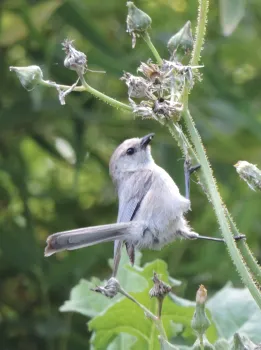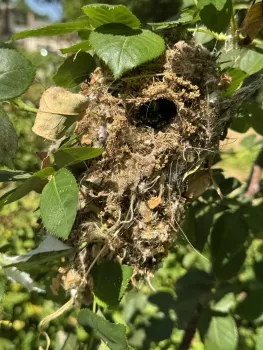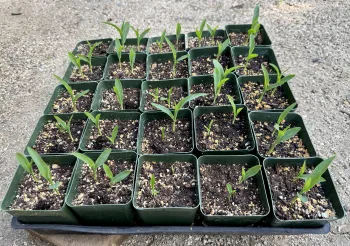Article by Peg Smith -

When working in the garden, it is wise not to presume that what looks like a collection of garden debris on a branch or limb is of no consequence. It may be of great value to a non-human cohabitant of the garden. Bushtit nests, from a casual look, appear as a collection of leaves and other plant parts but when examined it is clear they are carefully constructed nests to serve a specific purpose.
The bushtit is one of the smallest songbirds in North America at 4.3 inches and weighing only 0.18 – 0.21 ounces. It has an extensive range from southern British Columbia, Canada to Mexico and east into parts of Texas, Colorado, and New Mexico. They are found from sea level to ten thousand feet. Within that range, there are plumage differences, particularly in head coloration. In any location, to tell a male from a female, check the eye color. A male bushtit has brown or black eyes, while the female has yellow eyes. The Pacific bushtit is the one commonly found in our region.
Bushtits are welcome contributors to the health of a garden as they fly in flocks of ten to forty birds, flitting through a shrub or tree consuming insects ‘twittering’ to each other. Their predominant diet is small insects such as aphids, scale, and spiders, as well as beetles, caterpillars, wasps, and ants.

Their nesting habits follow a ‘it takes a village’ approach. Nests are found on trunks or branches from three to one hundred feet above the ground. The male and female hang test threads of spider web to determine a good nesting site. Having chosen a site for the nest the mating pair and associated adults will help build a nest sack a foot long from spider webs and plant materials, this may take a month. The nest is insulated with feathers, fur, and downy plant debris from seed heads, with a round opening at the top for access.
After a clutch of four to ten white, oval eggs is laid in the bottom of the nest, both parents take part in the twelve to thirteen-day incubation duties. They also share the responsibilities of care and feeding of the fledglings. It is common for the nest to be used for a second brood with the bushtits from the first brood helping feed the second brood. Unmated male bushtits also help in the feeding and care of the young. This ‘family’ grouping will sleep together in the large hanging nest. Once the young birds fledge they move to sleeping on close by branches.
If bushtits are disturbed during breeding and early nest building, they may leave the nesting site and sometimes find a different mate. So, if a flock of bushtits joins you while working in the garden, try not to disturb them. Appreciate the insect's ‘clean up’ job they accomplish, keep watch for a possible nest, then observe and enjoy.
June Tips
Water
The daytime temperatures have already flirted with 100°F. Summer heat is the challenge for new spring plantings; they will need to be watered evenly and often. For any new plant, large or small, the plant will only be able to pull moisture from the surrounding soil in a region approximately equal to the size of the root ball i.e., the size of the container from which it came. As the root system expands through the soil the plant’s ability to pull moisture from a larger region of soil will help it withstand our summer temperatures. Supporting new plantings with adequate water through the summer months is essential. Mulch will cool and reduce water loss from the soil. Deep regular watering for annuals and perennials will encourage root growth through the summer heat.
Ornamentals and annuals
Summer annuals of cosmos, marigolds, portulaca, sunflowers, and zinnias can still be added for summer color. Summer blooming perennials to plant are daylily, daisy, blanket flower, aster, sage, salvia, and yarrow. Please refer to the advice on adequate watering for new plants in the paragraph above.
Continue to deadhead roses as they fade. Cut stems at a forty-five degree angle one-quarter inch above a grouping of five leaves on the outside of the stem, this promotes continued bloom. A second bloom can be stimulated in California poppies if old flower stems are cut.
Potted plants and hanging baskets will develop well if they are consistently watered and are given an application of liquid fertilizer; follow the directions for timing and strength.
Diseases and Pests
Keep a close watch for any damage from insects, slugs, or snails. Rolled up newspaper for earwigs and beer traps set overnight for slugs and snails will help reduce their populations. Watch for aphids, whiteflies, hornworms, and powdery mildew. To identify and treat a problem refer to the UC IPM Website which describes the least environmentally toxic solutions.
Bulbs and rhizomes
If bulbs are spreading and becoming crowded, dig some of them up and store them in cool dry conditions to plant in the fall. If Iris are producing fewer blooms and their rhizomes are dense, dig them up and separate them into pieces, then replant them about a foot apart.
Mulching
To help control weeds and reduce soil moisture evaporation, apply a four-inch layer of mulch around plants and to cover open dirt. Watch for small holes in the dirt, which may be from ground-nesting bees. Wait and mulch that area later to allow the emergence of the next generation of native bees. For more information, refer to the Xerces Society article on Pollinator Conservation in Yards and Gardens.
Fruits
Make sure fruit is thinned to approximately six inches apart for apples, peaches, and nectarines. Note any fruit tree branches heavy with fruit and support with stakes to prevent limb breakage.
With the bloom period over and fruit set on grapes there are recommended methods to balance a healthy canopy and good fruit production. In the Vinyard, a year-round guide for grape growing from the UC Master Gardeners of Sacramento County gives monthly information and describes tasks to maximize the health and grape production of vines.
Lawns
Be aware of your city’s guidelines for watering. Grass can survive on less water than you think. A deep soak twice a week through the heat will encourage deep root development that will help your lawn handle the summer temperatures. If you are considering removing lawn, the summer is the ideal time to start the process. We classify lawn grass into three groups: green in winter, usually fescue and bluegrass; brown in winter, usually Bermudagrass, St Augustine, and Zoysia; Patchy grass with weeds, usually where most of our lawns graduate to as weeds opportunistically grow.
UC ANR Capitol Corridor’s PDF on Lawn Removal Methods gives a detailed guide for lawn removal.
Vegetables

Plant melons, cucumbers, summer squash, and winter squash. If growing melons or winter squash on the ground, as the fruit develops, rest the fruit on a piece of board or layer of mulch to avoid any rot from direct soil contact. These plants can also be grown vertically on a simple trellis. As melons and winter squash become heavy a sling of old towel or torn sheet tied to the trellis will give added support. The big advantage of trellising these vines allows more space for growing other vegetable favorites.
Corn can be planted from May through mid-July directly into the soil or started in pots and transplanted. To extend your corn-picking season, plant seeds every two to three weeks. This will provide ears of corn for the pot or barbeque throughout the summer.
If you are fond of basil, there are many wonderful varieties from the slightly spicy Thai to more common Genovese. If possible, place where the plants will have late afternoon shade. As the blooms develop, nip or cut them off, so the plant’s energy goes to leaf production instead of seed production.
Follow the golden rule of vegetable growing through our hot summer: deep, consistent watering and a three to four-inch layer of mulch.
Photos by Peg Smith
Click on the link below for

